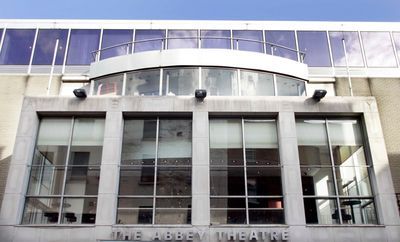Waking the feminists
By JAKI McCARRICK
On October 28, the Abbey Theatre, Dublin, announced a programme of ten new plays, Waking the Nation, which will mark the centenary of the Easter Rising in 1916. It was soon noticed that only one of the plays was written by a woman ��� hence a new movement, #wakingthefeminists, which has had a lot of attention in the media: see articles by Una Mullally, Martina Devlin, Sara Keating and Emer O���Toole. In a feature for the Irish Times, Fintan O���Toole refers to the funding (half a million euros) awarded to Waking the Nation by the Department of Arts, Heritage and the Gaeltacht, stating that ���astonishingly, the department admits that at no point did it seek to discover what the money would actually fund. The discussions were about the scale of the project, not its content���.
With Lian Bell and Sarah Durcan at the helm, #wakingthefeminists rallied a number of female artists to speak about parity in the arts at the Abbey Theatre and in Ireland more generally. Chaired by the Labour senator Ivana Bacik, the meeting took place at the theatre on Thursday, and I attended along with more than 500 of Ireland���s artists, writers and theatre-makers . . . .
Thirty noted figures gave powerful accounts of their experiences as "women artists" in Ireland. The playwright Amy Conroy said: ���we will not accept anything less than equality. No ifs, no ands, no buts���. The director Catriona McLaughlin said that ���no longer can women���s voices be neutered or ventriloquized���. Actors such as Derbhle Crotty and Janet Moran deplored the lack of plays written or directed by women. The London-based Irish playwright Nancy Harris could even say: ���we don���t know what women are writing because we are not hearing them enough���. And the playwright Gina Moxley brought the house down; ���we are not asking; we are coming in���, she said.
After these moving and often humorous speeches, it was over to the Abbey Theatre���s Artistic director, Fiach MacConghail, who admitted that he had ���failed to check his privilege��� and did not have gender balance in mind when programming the events for next year. Finally, the overall objectives for the #wakingthefeminists campaign were reiterated: equality for women artists; a sustained policy for inclusion with an action plan and measurable results; equal advancement of women artists; economic parity for all working in the theatre.
As I mentioned in a TLS review published earlier this year, since the new Abbey Theatre building opened in 1966 there have been six plays on the main stage by women ��� one each by Edna O���Brien, Jeanne Binnie and Elaine Murphy and three by Marina Carr. Over the same period there have been approximately 320 plays by men. The Abbey���s smaller Peacock Theatre has staged comparatively more work by Irish female playwrights, and overall the figure of total work by women at the Abbey is around 12 per cent (1.8 per cent on the main stage) of all programmes. We would do well to remember that there would be no Abbey Theatre were it not for the pioneering work of Lady Gregory as well as that of W. B. Yeats, and Annie Horniman's money allied to William Fay's management skills.
In their introduction to the book I reviewed, Irish Women Dramatists 1908���2001, Eileen Kearney and Charlotte Headrick suggest that the long neglect of female writers in Ireland has a lot to do with the financial risk involved in staging new plays ��� and with the female voice itself. They quote Linda Hart, who states in Making a Spectacle: Feminist essays on contemporary women���s theatre: ���The woman playwright���s voice reaches a community of spectators in a highly public place that has historically been regarded as a highly subversive, politicized environment . . . thus the woman who ventures to be heard in this space takes a greater risk than the woman poet or novelist���. There are other factors to consider: as Kearney and Headrick point out, ���the expansion of women���s rights on this unsceptered isle was a slow if steady uphill battle���, and until recently ���the Irish State���s laws and social provisions remained repressive of liberty in the two areas of sex and work���. In Ireland, there was a bar on hiring married women in the Civil Service until 1973.
In the UK, meanwhile, the National Theatre has staged hardly any plays by women on its main stage (Sarah Kane is to get her debut there with Cleansed, directed by Katie Mitchell, in February 2016). It's the same in the US. The Dramatist Guild of America states in its recent magazine that
���it was found that the percentage of women being interviewed, doing the interviewing or being the subject of the story ��� was exactly 20%. In the art museums, 80% of the art hanging on the walls is by men. The women���s work is stored in the basement. In orchestras, until the advent of blind auditions, 20% of the players were women. This 20% number is the real ceiling we are fighting in our lives and in our careers today���.
The same piece also points out the dangers of a situation in which women���s voices are silenced: ���the culture goes into what a UN friend of mine calls testosterone poisoning; women are the safety valve on the culture���.
What the next stage is for the Waking the Feminists campaign remains to be seen. Certainly, it has been a powerful agent of pressure and self-examination in Irish arts institutions. The playwright David Hare said in a recent BBC4 interview that ���it is the job of subsidized theatre to lead rather than follow��� ��� in which case, this could be an important moment for the Abbey Theatre, and for the arts in Ireland in general.
Peter Stothard's Blog
- Peter Stothard's profile
- 30 followers




